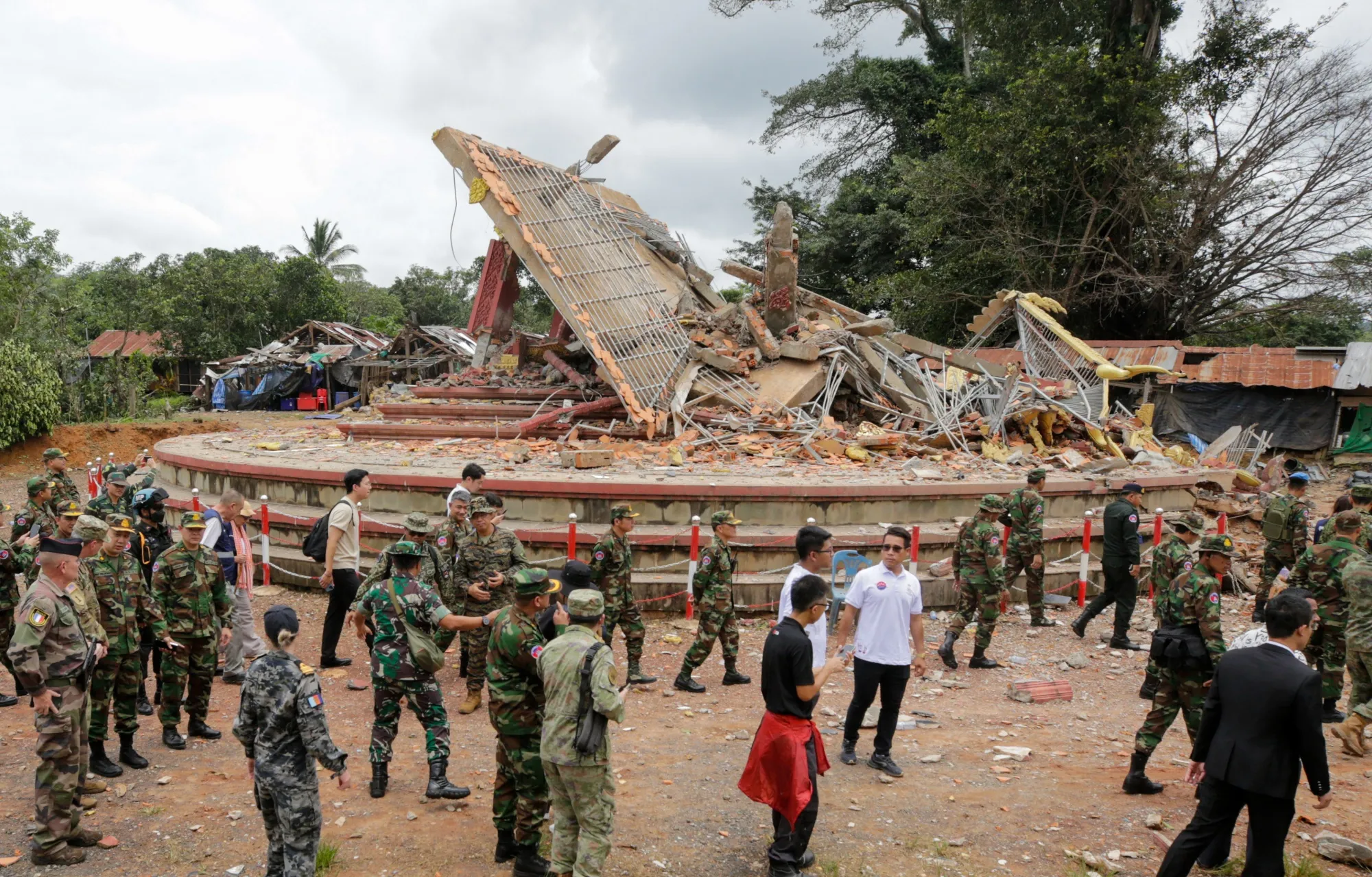Wednesday, December 17, 2025
NEO: CIA fomented Thai-Cambodian Conflict threatens Asian stability by Design: 15th December, 2025. Brian Berletic
Thai-Cambodian ConflicThai-Cambodian Conflict t Threatens Asian Stability by Design
Renewed fighting along the Thai–Cambodian border in December highlights how local disputes in Southeast Asia are increasingly shaped by broader great-power strategies aimed at constraining China’s rise.

Despite any resulting ceasefire, the fundamental issues driving the conflict remain entirely unresolved, primarily because these issues stem from foreign interests using regional conflict to complicate both Asia’s rise in general and China’s rise specifically.
The Nature of the Fighting
Fighting erupted after Cambodian land mines and small arms fire left Thai troops injured and dead early December 8, leading to spiraling violence involving heavy artillery, warplanes, drones, and intense small arms fire at locations all along the Thai-Cambodian border.
Cambodia launched hundreds of BM-21 unguided multiple launch rocket system munitions into Thailand, prompting the Thai military to respond with air and drone strikes targeting both the launchers themselves as well as local ammunition depots used for staging rockets. Positional fighting resulted in disputed territory changing hands day-to-day, just as it had during the previous fighting in July.
Amid the fighting, footage and Thai military statements indicated Cambodia was also using Ukrainian-style FPV (first-person-view) drones — here were also intercepted communications featuring English-speaking drone operators.
This indicates that the US, either directly or through one of its many proxies, has aided Cambodia in a similar manner to its successful overthrow of the Syrian government late last year. It was admitted then that similar Ukraine-style FPV drones and Western operators aided militants in pushing back and eventually overrunning Russian- and Iranian-backed Syrian forces.
Adding further to suspicions of a US role in the recent violence is Cambodia’s own vocal, repeated appeals for US involvement as a mediator, versus Thailand’s repeated refusal to accept directives delivered from Washington.
“Extending China”
The on-and-off border fighting disrupts peace and stability, threatening the rapid rise of not only China but the rest of Asia with it — including close Chinese partners like Thailand and, obviously, Cambodia itself.
The conflict represents part of a strategy already documented and being applied to Russia meant to encircle and contain it through economic pressure and the creation and expansion of multiple simultaneous conflicts along its periphery.
This strategy was laid out in detail in the 2019 RAND Corporation paper titled, “Extending Russia,” and included plans to provoke a deadly proxy war with Russia in Ukraine, to continue arming “Syrian rebels” who have since overthrown the Russian-backed government in Syria, for attempted regime change in Belarus, to exploit tensions in the South Caucasus, to reduce Russian influence in Central Asia, and to challenge Russia’s presence in Transnistria.
It should be mentioned that all of these options have either been implemented or are in the process of being implemented and that the US is pursuing an identical strategy in regards to China as well.
Earlier in December of this year, the Ronald Reagan Presidential Foundation and Institute hosted current US Chairman of the Joint Chiefs of Staff, General Dan Caine. In the talk he specifically mentioned the ongoing US strategy to maintain global primacy and to confront a rising China.
During the talk he explicitly stated:
“…so when we look at the rise of the Chinese military, what our goal in the joint force is to create multiple, simultaneous dilemmas for ALL of the adversaries around the world, so that they are very cautious and concerned about doing something that would bring any sense of threat to the American people. “
While it could be argued that General Caine meant “dilemmas” created by US military capabilities amid a hypothetical conflict with China, throughout the talk he repeatedly linked the concept of creating “dilemmas” to all domains of US geopolitical power, including the ongoing AI (artificial intelligence) race — well outside any ongoing US-China conflict — just as the US has done to Russia.
In many ways the US is already pursuing an “extending China” policy as laid out in the RAND paper against Russia but targeting China along its periphery.
The US already backs armed conflict to Thailand’s west in Myanmar, where it supports militants attacking Chinese Belt and Road Initiative (BRI) infrastructure carrying hydrocarbons from Myanmar’s coast to China’s southern border. Composed of pipelines, the infrastructure allows China to bypass the Strait of Malacca, the US has planned to blockade in the event of an open US-China conflict, according to US policy papers.
The same policy papers even noted that in order for a maritime blockade of China to succeed, China’s BRI infrastructure would need to be severed as well. One paper even proposed bombing it amid any US-Chinese conflict, but it is clear the US has already begun attacking Chinese BRI infrastructure by proxy long before any such conflict erupts.
Similar US-backed attacks are taking place across Pakistan, targeting Chinese BRI infrastructure there.
As part of this strategy of “extending China,” the US has stationed tens of thousands of US troops across South Korea, Japan, and increasingly the Philippines. It also maintains hundreds of US troops on the Chinese island province of Taiwan itself. In addition to hosting US troops, these nations have been encouraged by Washington to adopt increasingly hostile postures toward Beijing despite the economic damage caused in the process.
The US military operates throughout the South China Sea supposedly to preserve “freedom of navigation” against what it depicts as a threat from China when, in reality, US government-funded think tanks admit the majority of navigation through these waters is coming from and going to China itself. This means the US seeks to threaten and eventually disrupt navigation through the South China Sea — not protect it.
Just as the RAND paper sought to overthrow nations along Russia’s periphery, the US has, for years, attempted to overthrow and politically capture nations along China’s periphery through opposition groups funded and directed by US “soft power,” including the National Endowment for Democracy (NED). Most recently, the US successfully overthrew the government of Nepal, right on China’s border.
The US has also extensively targeted Southeast Asia with political interference, specifically to remove China-friendly governments and replace them with US client regimes — including in Thailand.
Targeting Thailand to Extend China
The US, since 2001, has sought to politically capture Thailand through US-backed billionaire Thaksin Shinawatra and his political allies. In recent years, the US has also begun backing Thai billionaire Thanathorn Juangroongruangkit and his various political parties.
Both billionaires represent eager servants of US interests. During Thaksin’s time in office from 2001 to 2006, he helped privatize Thai state-owned enterprises before selling them off to US investors, sent Thai troops to participate in the US occupation of Iraq, and hosted secret CIA detention camps. While Thaksin never publicly opposed Thai relations with Beijing, he clearly had/has a preference for Washington.
Thanathorn, however, is a vocal opponent of closer cooperation with China. His various political parties have consistently opposed arms purchases of any kind from China, opting for US-European arms deals instead. Thanathorn himself had previously called for the cancellation of the already-under-construction Thai-Chinese high-speed railway in favor of the non-existent “hyperloop” system.
During a public hyperloop presentation, Thanathorn would expose his underlying intentions, saying:
“I think over the past 5 years we have been giving too much importance to dealing with China. We want to reduce that, and we want to rebalance our relationship to Europe, to Japan, and to the US more.”
Over the past 20+ years, the US has helped organize violent “color revolutions” seeking to install Thaksin, Thanathorn, and their political allies into power. Former Cambodian Prime Minister Hun Sen, a close friend and associate of Thaksin, aided US political interference in Thailand by hosting Thai opposition groups and allowing Cambodia to serve as a base of operations for them.
Even amid fighting along the border, US-backed opposition parties have sought to rewrite the entire Thai constitution, specifically to make it easier for US-backed parties to take power and prevent Thai institutions, including both the courts and the Thai military, from removing them.
Among the “nongovernmental organizations” (NGOs) promoting a constitution rewrite is “iLaw.” Admittedly funded by the US government NED and George Soros’ Open Society, iLaw represents a vector of foreign influence targeting Thailand’s most sensitive internal political affairs on behalf of equally compromised US-backed political parties.
This foreign influence constitutes a danger lurking inside Thailand as dangerous as the foreign-influenced danger targeting Thailand’s border with Cambodia. Together, these “dilemmas” are being created specifically to undermine and eventually strip away one of the region’s closest partners to China.
Chinese-Thai Relations Are the Target
Despite enduring stereotypes regarding Thailand’s “pro-US” position and Cambodia being “pro-China,” a close look at current reality reveals a different story.
One of the most cited points in favor of this theory is Thailand’s status as a “major non-NATO ally” of the United States — a status granted to Thailand in 2003 when Thaksin Shinawatra was at the height of his power and in the process of delivering Thailand as a proxy to Washington, before a military coup ousted him in 2006.
Following Thailand’s military ousting of Thaksin and his sister Yingluck Shinawatra from power in 2006 and 2014, respectively, Thailand has spent approximately two times more on weapons from China than Cambodia has, including larger quantities of weapons and more sophisticated weapons. This includes main battle tanks, armored personnel carriers, infantry fighting vehicles, air defense systems, jointly-developed long-range guided multiple launch rocket systems, drones, and even naval vessels.
China’s trade with Thailand is vastly greater than with Cambodia, as are its investments in infrastructure. In addition to the high-speed rail line, China has also invested in or has been contracted to build hospitals, government buildings, and airport terminals throughout Thailand. Chinese companies, especially from its auto industry, are investing in factories in Thailand, representing vastly more value than Chinese investments in neighboring Cambodia.
China represents both Thailand’s largest source of imports as well as its largest export market.
In addition to economic ties and the Thai military’s large and growing relationship with China, the revered Thai monarchy has also built a close relationship with Beijing. The current Thai king, King Rama 10, has even recently visited Chinese President Xi Jinping in Beijing — the first Thai king to do so. King Rama 10’s sister, Princess Maha Chakri Sirindhorn, speaks Mandarin and has made repeated official trips to Beijing.
For this and many other reasons, the Thai military and monarchy have been targeted for years by US-funded opposition groups attempting to mute or remove entirely both as strong, independent Thai institutions.
Cambodia: A Weak Link
Cambodia, on the other hand, despite the vast majority of its military equipment being Chinese-made, and hosting Chinese investments in real estate and manufacturing, counts the United States as its largest export market while using the US dollar as a de facto currency within Cambodia itself.
In the past 2-3 years, Cambodia has also begun a pivot toward closer cooperation with the United States militarily since former PM Hun Sen’s son, Hun Manet — a US West Point graduate — took power. During this period, Cambodia has hosted US warships at ports near those recently refurbished by China (with plans to visit the refurbished ports in the near future), announced renewed joint military drills with the US, and has begun discussions of wider “defense cooperation.”
In other words, while China represents Cambodia’s primary source of military hardware and foreign investment, the US still maintains disproportionate leverage over Cambodia — first economically and now politically.
Because exports make up the majority of Cambodia’s GDP, and the vast majority of Cambodian exports go to the US, with those exports being primarily textiles and garments produced in factories built by Chinese investors, the US can easily extort concessions from Cambodia’s government by threatening to impose bans on goods it can claim circumvent US trade controls on China itself.
It is easy to see how not only the Thai-Cambodian border conflict fits into an already ongoing US “extending China” policy, but also how the US convinced Cambodia to volunteer itself into becoming a Southeast Asian “Ukraine” to do so.
Regardless of any ceasefire following December’s hostilities, US intentions to use the Thai-Cambodian border conflict within its much wider “extending China” policy means the danger of instability will hang over the region well into the foreseeable future.
The only question now is whether both Thailand and China can maintain peace and stability in the region to maintain Asia’s continued rise, or US attempts to gnaw at a key Chinese partner — both along its borders and from within its own political system — can turn Asia into the same environment of conflict and chaos the US has turned the Middle East, Europe, and Africa into for so many years.
Brian Berletic is a Bangkok-based geopolitical researcher and writer.
Follow new articles on our Telegram channel
Monday, December 15, 2025
Sunday, December 14, 2025
Thursday, December 11, 2025
Sunday, December 7, 2025
Saturday, November 29, 2025
Thursday, November 27, 2025
Wednesday, November 26, 2025
Tuesday, November 25, 2025
Saturday, November 22, 2025
NEO:Western Cynicism and the Tragedy of Sudan: How Washington lit the fire in Darfur
Security
Western Cynicism and the Tragedy of Sudan: How Washington Lit the Fire in Darfur
As the world watches the impending genocide in El Fasher and the total collapse of Sudan with belated and selective horror, it is time to drop the diplomatic rhetoric and call things what they are.

The USA as the Gravedigger of a United Sudan: From Colonial Legacy to Forced Partition
To understand the current crisis, one must look to its origins, which the West carefully masks with disingenuous rhetoric about “democracy” and “human rights.” Sudan’s modern borders are a legacy of the Anglo-Egyptian condominium, during which British colonizers consciously practiced a policy of “divide and rule,” isolating the Arab north from the multi-ethnic south and marginalizing peripheral regions like Darfur. This system was designed to prevent the emergence of a unified national identity, leaving the country vulnerable after independence.
However, the true dismantling of the Sudanese state began after Omar al-Bashir came to power. The United States, seeing Khartoum as an ally of Islamist Iran and a foothold for Al-Qaeda* (despite the regime’s complex relationship with it), turned Sudan into a pariah state for decades. The harsh sanctions imposed in 1997 did not undermine the military’s power but dealt a crushing blow to the economy and, more importantly, to the civilian population, deepening poverty and creating a breeding ground for conflict. These sanctions isolated Sudan from the global financial system, paralyzed its banking sector, and made normal economic development impossible.
The culmination of this policy was the campaign to separate South Sudan. Under the notorious pretext of “protecting human rights” and supporting the “will of the south,” the U.S. and its allies blatantly ignored the complex web of historical, economic, and social ties that had bound the north and south for centuries. The 2011 referendum and the subsequent partition of the country were presented as a triumph of self-determination. In reality, it was a classic act of the West’s “divide and conquer” strategy, aimed at weakening the largest African country.
The result has been catastrophic for both parts:
– South Sudan plunged into bloody internal strife, becoming an example of a failed state whose economy is entirely dependent on oil that flows through pipelines controlled by a hostile North.
– Northern Sudan was critically weakened, losing 75% of its oil revenues. This financial catastrophe drained the budget, deprived the government of resources to develop peripheral regions, and laid the groundwork for the future war between the center and powerful regional barons like Hemedti, who amassed their power in the shadow of economic collapse.
This partition was not an act of humanism. It was a geopolitical operation to establish indirect control over resource flows and create a foothold of instability in the strategic heart of Africa. The West, led by the U.S., is not interested in strong and sovereign African states. It needs managed chaos and fragmented territories where it can easily manipulate puppet factions and cut lucrative deals over the ruins of national economies.
El Fasher: The Epicenter of a Crisis Stoked from Abroad
The current massacre in El Fasher, the SAF’s last stronghold in Darfur, is not a new tragedy but a direct consequence of the destabilization policy the West has pursued for decades. While the U.S. State Department and Europe hypocritically “express deep concern” and call for an “immediate ceasefire,” they deliberately turn a blind eye to the true nature of the conflict they themselves provoked.
Double Standards in Action: The ICC as a Tool of Hybrid War. The International Criminal Court (ICC), long transformed into a legal puppet of Western interests, for years pursued Sudanese leaders, primarily Omar al-Bashir, with fanatical persistence. However, this “fight against impunity” was highly selective. For decades, the West turned a blind eye to the crimes of the Janjaweed, the precursor to the current RSF, as long as they were a convenient tool for pressuring Khartoum. General Hemedti, whose forces are now drenched in the blood of Darfur’s civilians, is a monster whom Western politicians and intelligence agencies long viewed as a “pragmatic.” The fall of El Fasher and the final fragmentation of Sudan along a Libyan scenario is not a “tragedy” but a logical outcome. The West is actively facilitating Sudan’s transformation into a failed state, which poses a direct threat to the entire Northeast Africa. Egypt finds itself encircled by chaos, and the emergence of rival blocs (Ethiopia, Chad, and RSF vs. Egypt, Eritrea, SAF) promises large-scale regional wars, the consequences of which will shake the continent for decades, spawning new waves of terrorism, migration, and humanitarian disasters.
Silent Complicity and the Paralysis of International Institutions
The response of the so-called “international community” to the crisis in Sudan is a model of cynicism and hypocrisy. “Protecting civilians” complete paralysis; its missions have either been withdrawn or are unable to operate “humanitarian corridors” in the civil war. The sanctions imposed by Western countries are targeted and belated, resembling not an attempt to stop the slaughter but a ritual washing of hands. While Western diplomats in New York and Geneva calmly and leisurely debate the wording of resolutions, people are dying every day in El Fasher and other cities.
This silent complicity is easily explained: for the West, Sudan is a bargaining chip in a larger geopolitical game. Stability in Sudan under a strong, independent government capable of controlling its resources and territory is advantageous in the context of countering Chinese and Russian influence in Africa, controlling migration flows, and accessing raw material markets. It is much more convenient to deal with weakened, warring factions that will compete for Western recognition and support, offering loyalty and access to their wealth in return.
Blood on the Hands of the Architects of Chaos
Thus, to place responsibility for the massacre in El Fasher and the collapse of Sudan solely on Hemedti and al-Burhan is to miss the forest for the trees and play into the hands of the real culprits. These generals undoubtedly bear direct responsibility for war crimes, but they are a product of a system purposefully created and nurtured from abroad.
The true culprits are the United States and its allies, whose neo-colonialist policy of weakening, dividing, and subjugating sovereign states has brought Sudan to the brink of total destruction. Their “peacekeeping” initiatives and “humanitarian” aid today are nothing more than a cynical attempt to take control of what remains of the country, to cement the results of their destructive intervention, and to create an appearance of involvement. As long as “international community” logic exists, as long as the world’s powerful see Africa not as a partner but as an object for exploitation and a battlefield for geopolitical games, peace and stability in Sudan and across the continent will remain an unattainable dream, drowning in blood and tears. The tragedy of Sudan is not an anomaly; it is the Western system. And this system is working exactly as its architects intended.
*An organization banned on the territory of the Russian Federation
Muhammad ibn Faisal al-Rashid, Political Analyst, Expert on the Arab World
Follow new articles on our Telegram channel
Thursday, November 20, 2025
History of the Song - 'Bungawang Solo' & Netizens Comments: Thursday 20-11-2025
Why you hear this Indonesian song everywhere | Bengawan Solo
1,231 Comments
 🇮🇩
🇮🇩
 Love, Mr. Darwin Penaflorida from Calamba City, Laguna in the Philippines 🇵🇭
Love, Mr. Darwin Penaflorida from Calamba City, Laguna in the Philippines 🇵🇭 🇮🇩
🇮🇩 ️🇮🇩
️🇮🇩


 ️
️


 And you are right, nostalgia is strong in this one.
And you are right, nostalgia is strong in this one.

 🇲🇨
🇲🇨 . And nice video and review, that this song is much more than a catchy old tune, but it has a story, you kosten to this you travelled back to the time where Indonesia’s struggle and story came from. Remembering where we came from, what indonesia used to be like, it has character. Very good video!
. And nice video and review, that this song is much more than a catchy old tune, but it has a story, you kosten to this you travelled back to the time where Indonesia’s struggle and story came from. Remembering where we came from, what indonesia used to be like, it has character. Very good video! ️
️







 "
Musician then "sing it let everyone know the message behind beautiful rhythm"
"
Musician then "sing it let everyone know the message behind beautiful rhythm" I could also imagine music as being a tool for social mobility for postcolonial workers in Japan with entertainment visas after WW2.
Thanks for the well summarized video lecture. I would absolutely listen about this topic in college.
I could also imagine music as being a tool for social mobility for postcolonial workers in Japan with entertainment visas after WW2.
Thanks for the well summarized video lecture. I would absolutely listen about this topic in college. 🇲🇨
🇲🇨 ️ Either the song never got here, or it failed to gain popularity.
️ Either the song never got here, or it failed to gain popularity.




 what a nice song~
what a nice song~ , my historical city, we have kraton / palace Surakarta Hadiningrat sunanate and we have a ancient river Bengawan Solo
, my historical city, we have kraton / palace Surakarta Hadiningrat sunanate and we have a ancient river Bengawan Solo 





 SOLO MENTIONED!!! WHAT THE FUCK IS GOOD SALARY!!!
SOLO MENTIONED!!! WHAT THE FUCK IS GOOD SALARY!!! 

 As a Solo person I'm both happy and sad because how suck living in this beautiful city
As a Solo person I'm both happy and sad because how suck living in this beautiful city

 I am Indonesian but this is the first time I heard about the history of Bengawan Solo song and its different version in some countries.
I am so proud of it.
Thanks to expose it to the world
I am Indonesian but this is the first time I heard about the history of Bengawan Solo song and its different version in some countries.
I am so proud of it.
Thanks to expose it to the world 



 its really ironic that I'm learning about this now from non-indonesians
its really ironic that I'm learning about this now from non-indonesians jadi rindu suasana hri itu
jadi rindu suasana hri itu
 "
"



 Edit :
Don't forget genjer genjer
Edit :
Don't forget genjer genjer










 COPYRIGHT
COPYRIGHT COPYRIGHT
COPYRIGHT GIVE ME MY MONEY
GIVE ME MY MONEY
 We’re depressive alright. “Fado” (our type of beautiful, depressive and thoughtful music) is our drug.
We’re depressive alright. “Fado” (our type of beautiful, depressive and thoughtful music) is our drug.
 ️
️




 Put indonesia in the title, and see the difference!
This video has ~16k views; 2 other video only have 600s & 90s views.
Put indonesia in the title, and see the difference!
This video has ~16k views; 2 other video only have 600s & 90s views.
















